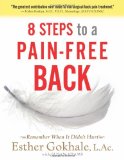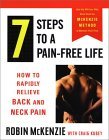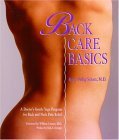Commonness of Back Pain
Roughly 60 to 80% of 30 to 60 year olds suffer from back pain. Back pain has long become widespread. About 50% of back pain cases are job-related. There are no exact causes for back pain for about 75% of the cases. Physical as well as mental reasons are responsible for these unspecific types of back pain.
Back pain is usually caused by muscular or mental causes. The back muscles frequently become cramped as a result of job-related or private stress. The consequences are tension and muscle hardening which lead to back pain.
The most common cause of chronic back pain is caused by “wearing out”, the so called osteoarthritis of the spine.
Causes of Back Pain
- Muscle tension: Stress is a common trigger factor of back pain. Stress tenses the back muscles and causes pain. Relaxation techniques such as progressive muscle relaxation, yoga and autogenic training can help. Psychological conversations are often helpful.
- Skeletal illness (e.g. osteoporosis (bone loss))
- Deterioration: Wearing out of the spine (vertebral body, intervertebral discs)
- Inflammations (e.g. rheumatism)
- Deformations (scoliosis, Scheuermann’s disease)
- Injuries (e.g. whiplash injuries, fractures)
Lumbago
Lumbago is often caused by abrupt movements such as picking up, bending over or twisting. Even coughing and sneezing can trigger the lumbago.
Cause of the Lumbago:
A slipped disc or intervertebral swelling happens when the gelatinous central portion of the disc, which pushes outwards, presses on the nerves which leave the vertebral canal.
Symptoms of the Lumbago:
Sudden penetrative pain in the lower back area and backside which does not spread to the legs. It is usually difficult to stand up straight with this type of pain. Bending to the side is the relieving posture.
Sciatica (Sciatic Pain)
Sciatica is caused by the same reasons as the lumbago.
Causes of Sciatica:
There are many causes for sciatic pain. The sciatica nerve is irritated or even squashed as a result of a change in the lumbar spine – often caused by a slipped disc. A common cause of pain is also neuritis or tension in the back muscles.
Symptoms of Sciatica:
Pain spreading in the legs, even partly in the foot.
Slipped Disc
The intervertebral discs, which lie between the vertebrae, are damaged. The intervertebral discs lose their shape and press against the nerve tracts of the spinal marrow. Considerable changes of an intervertebral disc occur when the fibrous ring is injured and torn causing the gelatinous centre to be pushed through.
Symptoms of a Slipped Disc
Characteristic is pain that spreads into the legs and even signs of crippling.
Scheuermann’s Disease
This is probably a genetically conditioned growth disorder, which usually occurs in the thoracic vertebral region. The growth disorder usually develops between the ages of 11 and 15 and forms a distinctive humpback.
Scoliosis (Curvature of the Spine)
Scoliosis is the curving and twisting of the spinal column. This can even occur in children.
Back Pain, that is not connected to the spinal column:
Projected Pain
- Cervical spine: diseases of internal organs such as the liver, gall bladder, stomach, heart
- Thoracic spine: projection of pain with illnesses of the oesophagus, lungs and arteries
- Lumbar spine: projection of pain with gynaecological or urological illnesses.
Myofascial Syndrome
- Back pain with or without referred pain can also be caused by muscles next to the spinal column and / or the related tendons.
The Spinal Column
The spinal column is the most complicated part of our locomotor system. The spinal column carries the head and the torso and protects the spinal cord which is enclosed in the spinal column. The spinal column consists of 24 vertebrae altogether. The vertebrae in the lumbar spine area (at the bottom) are the biggest. The load of the spinal column also increases in the direction of the lumbar spine. Therefore degenerative changes and pain in this area are particularly common. In between the vertebral body are intervertebral discs. An intervertebral disc is a fibrous, rough ring (anulus fibrosus) which has a gelatinous centre (nucleus pulposus). The gelatinous centre causes pressure equalisation. When pressure is placed on the disc it causes fluid to be released and the disc becomes flattened during the course of the day. This means that at the end of the day the spinal column could be up to 2 centimetres smaller than in the morning. The horizontal resting position at night enables the intervertabral disc to stretch itself out again. However the ability to do this decreases considerably with age. The human being becomes smaller after the age of 25. A man can shrink 3 centimetres and a woman 6 centimetres between the ages of 20 and 70.
top  |
Treatment for Back Pain
The methods of treatment for back pain are just as diverse as the causes.
One can generally say that more movement, strengthening the back muscles and getting rid of bad posture all contribute to improving back pain and preventing chronic back pain.
In order to avoid chronic pain, one should begin with therapy as early as possible. Many people who get back pain try to move as little as possible out of fear of the pain. This kind of “avoiding pain behaviour” can cause the pain to become slightly chronic. For this reason, it is recommended to resume physical activity as quickly as possible.
Treating back pain by:
- Heat therapy treatment
- Physiotherapy
- Massaging
- Relief
- Chiropractic therapy
- Operations: An operation of the intervertebral disc is only necessary if neurological failure occurs. Problems with the bladder and the intestines are also included.
- Psychotherapy
- Relaxation exercises: Numerous health insurance brochures and books describe relaxation exercises for the muscles in the back (back care programmes).
- Losing excess weight
Preventing Back Pain
Many back problems are caused by repeated, uniform movements that strain the back.
Lying Properly
The mattress should correspond to the body weight. The pillow should support the head and the neck and should not slide under the shoulders. The head and the spinal column should form a straight line.
Sitting Properly
Avoid sitting for long hours in the same position. Regularly change your seating position. Stand up more often and stretch. Avoid hunching the back. Make sure the seat height is right. Both feet should touch the ground completely and the knees should be bent at least at a 90 degree angle.
Carrying Properly
Spread out the load evenly on both arms. Take two shopping bags instead of one big one.
Picking Up Properly
Carry loads close to the body and always pick up heavy loads in a squatting position. Do not bend your spinal column when picking up and do not make any rotational movements of the upper body. Keep the back straight.
Doing Housework
Avoid unnecessary bending over. Use a long mop and a vacuum cleaner that has a long vacuum hose. Avoid slouching. Squat or kneel.
Types of Sports for Back Pain
Sports that are ideal for avoiding back pain:
Aerobics, walking, hiking, cycling, swimming, dancing
Sports, that strain the back:
Badminton, lifting weights, golf, hockey, rowing, Alpine skiing, squash
Back Pain as a Medical Emergency
Back pain can also be an indication of a medical emergency. If, in addition to back pain, you suddenly become numb in the iliac region, the muscular strength in one or both legs fails or you can no longer control defecation and urination you should immediately seek medical advice.
top 

8 Steps to a Pain-Free Back: Natural Posture Solutions for Pain in the Back, Neck, Shoulder, Hip, Knee, and Foot, Esther Gokhale, Susan Adams

Healing Back Pain : The Mind-Body Connection

7 Steps to a Pain-Free Life: How to Rapidly Relieve Back and Neck Pain

Back Care Basics: A Doctor's Gentle Yoga Program for Back and Neck Pain Relief
top  |

